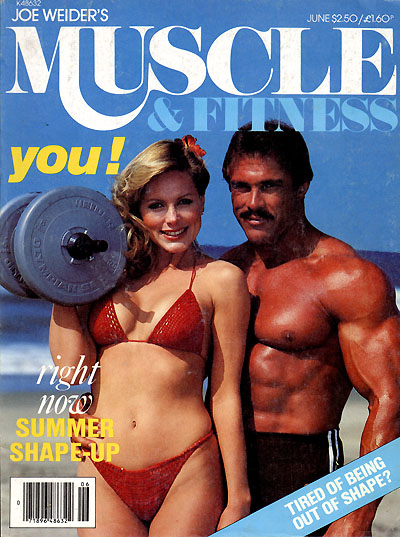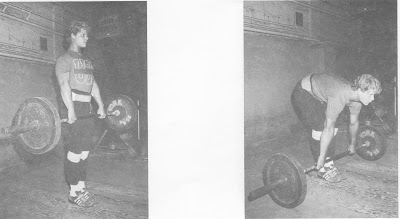First Issue
Latest Issue
WINTER MASS WORKOUTS
by
Sean Hyson (2015)
Forget about abs and calves. Use these cold months to add size and strength with the most effective exercises known to man.
RELAX. Abs season is over. You don't have to meticulously count every gram of carbs and fat anymore, because even if you do keep your abs over the next few months, no one but your girlfriend will have a chance to see them. It's wintertime, and for most of the country that means a return to long sleeve shirts and pants, holiday parties and comfort foods -- all things that will conspire to rob you of your definition and steadily expand your waistline.
And rather than fight it, we say EMBRACE IT. December through March is the perfect time to shift your training to a powerbuilding split focused on putting up big numbers and adding prime beef to your frame so that when spring comes back, you'll only need a few weeks of dieting to shed your "winter coat" and reveal the dense muscle beneath it.
To this end, we polled three of our favorite experts -
Joe DeFranco, a strength coach to several pro football players
CJ Murphy, a strength coach, powerlifter and all-around badass
and Mike O'Hearn, a bodybuilder, powerlifter and former American Gladiator
to get their picks for the best muscle- and strength-building exercises, period. We then mixed as many of them as we could together to fashion a damn fine mass-gain program that will have you setting new PRs -- safely -- while pumping up the muscles that show behind even the ugliest Xmas sweater: the traps, shoulders, chest, and arms. We bet that you will enjoy this routine so much you'll wish it stayed winter forever. (Almost.)
Directions
Perform each workout (Days I, II, III, and IV) once per week. Exercises marked with an asterisk (*) indicate they should be rotated with similar movements each week. For example, on the first leg day, you can do the classic back squat one week, then a box squat the next, and a pause squat in Week 3. (If you have access to special bars, like a safety squat bar, you can use these as well for more variety.) On upper body days, you can rotate among the bench press, incline bench press, and floor press, just as examples.
On the second leg day, you can opt for any variety of deadlift you like (such as trap bar, sumo deadlift, or conventional deadlift); you can also change the height of the bar, choosing to do deficit deadlifts (where you stand on a platform to increase the range of motion), or rack pulls (where you rest the bar on a rack or blocks just below knee level to shorten the range of motion). Cycle the lifts as you like or need to, depending on recovery and how your lower back and shoulders feel.
On all of the main lifts (squat, bench press, deadlift) and their variants that you cycle, you'll work up to a one- to 10-rep max. Begin with an empty bar and gradually add weight until you reach a load that cuts you off at a certain number of reps within that range. You can shoot for a 10-rep max one week on one lift and then an 8-rep max on another lift the next week. You can work down to a one-rep max over time or play it safe and stay within 5 to 8 reps. It's up to you and how far you want to push your strength gains. Just be aware that repeatedly training very heavy (5-rep maxes or heavier) wil be stressful and will require occasional deloads. Once you reach the load that allows you the number of reps you're shooting for but no more, you're done with that lift for the day.
Blog author's note: While using this layout I found the list of Big Three Lift variations included here to be very useful:
http://www.syattfitness.com/westside-barbell/the-westside-barbell-conjugate-method-a-guide-to-variation/
Blog author's note: While using this layout I found the list of Big Three Lift variations included here to be very useful:
http://www.syattfitness.com/westside-barbell/the-westside-barbell-conjugate-method-a-guide-to-variation/
Note that SOME OF THE EXERCISES ARE ALTERNATED. This means you'll do one set of the first lift, REST, then do one set of the second lift, REST AGAIN, and repeat until all the sets are completed.
DAY ONE: LEGS AND CORE
Lying Leg Curl, 3 sets of 15 reps.
Set up the machine so that the foot pad rests just above your ankles as you do the reps. Squeeze each rep at the top contracted position for 1 to 2 seconds.
* Squat Variant *, as many sets as needed, one to 10 reps.
Keystone Deadlift, 2 sets of 6-8 reps.
Hold the bar at arms' at your thighs. Push your hips back and lower your torso until the bar reaches the top of your knees. It is similar to a Romanian deadlift, only with a shorter range of motion, and it's also easier on the lower back.
Bulgarian Split Squat, 3 sets of 8 one-and-one-half reps each leg.
Hold a dumbbell in each hand and stand lunge length in front of a bench. Rest the top of one foot on the bench behind you. Bend both knees and lower your body until your rear knee nearly touches the floor. Keep your torso upright. To perform one-and-one-half reps lower your body into the bottom position and then come up halfway. Go back down and then come up to the start position. That's one one-and-one-half rep.
Ab Wheel Rollout, 3 sets of 8-15 reps.
DAY TWO: CHEST, BACK, SHOULDERS, TRICEPS
Alternating Incline Dumbbell Press, 3 sets of 12-15 reps each side.
* Bench Press *, as many sets as needed, one to 10 reps, alternated with
Chest Supported Row, 4 sets of 8-12 reps.
Lateral Raise, 3 sets of 10-12 reps.
Incline Tate Press, 3 sets of 15 reps.
Set a bench to an incline and lie back with a pair of dumbbells locked out overhead. Flare your elbows out and lower the weights in toward your chest.
DAY THREE: LEGS, TRAPS, CORE
Glute Ham Raise, 3 sets of 10-12 reps.
Front Squat, 2 sets of 8 reps.
* Deadlift *, as many sets as needed, one to 10 reps.
Dumbbell Shrug, 3 sets of 12-15 reps.
Back Extension, As many sets as needed, 50 total reps.
One-Arm Farmer's Walk, 2 sets, as far as possible.
Hold a heavy dumbbell in one hand and walk as far as you can while keeping your torso upright and straight. Alternate sides each set.
DAY FOUR: CHEST, SHOULDERS, BACK, ARMS
Seated Dumbbell Overhead Press, 3 sets of 10-12 reps, alternated with
Pullup, 3 sets of as many reps as possible.
Grab the bar with a wide grip. Keep your back flat and initiate the pull by retracting your shoulder blades. Initiate each rep from a dead hang; don't use momentum.
Cable Flye, 3 sets of 15 reps, alternated with
One-Arm Dumbbell Row, 3 sets of 10-12 reps.
Face-Pull, 3 sets of 15-20 reps.
Attach a rope handle to the top pulley of a cable station and grasp an end with palms facing each other. Pull the rope to your forehead while flaring your elbows out until your back is fully contracted.
Concentration Curl, 4 sets of 8 one-and-one-half reps.
Sit on a bench with a dumbbell in one hand and brace the back of your arm against the inside of your thigh. Perform a strict curl movement and then lower the weight one half of the way back down. Curl it all the way up again and then lower it fully. That's one one-and-one-half rep.
Band Pushdown, as many sets as needed to complete 100 total reps.
Attach a band to the top of a power rack or other sturdy surface and grab an end in each hand. Perform pushdowns as you would at a cable station, but do as many reps as needed to reach 100 reps, resting along the way.









































